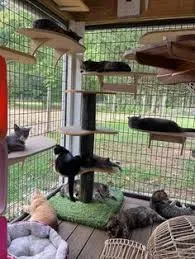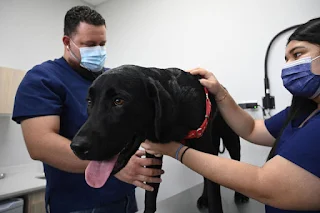In recent times, a new, mysterious illness has been emerging in the canine world, raising concerns among pet owners and veterinarians alike. This illness, still unnamed and not fully understood, has been observed in various locations, leading to a growing need for awareness and understanding among dog lovers.
I have been aware of this illness for some time due to a video posted online by The Asher House. Mr. Asher has a YouTube channel that features him talking about his rescue efforts and introducing the myriad dogs he has living on his sanctuary. It is obvious to anyone who watches him that he loves these dogs and wants them to live healthy and happy lives.
But, back 3 months ago, he talked about how the animal community in Oregon was being hit by a mysterious disease for dogs. His dogs were becoming sick at an alarming rate. Several of his dogs died from this illness, but due to the fact that he takes in sick, old, and disabled dogs to his sanctuary, he felt that was unavoidable. He posted several videos about what was going on in Oregon and with his dogs. He worked tirelessly with the Veterinarians in Oregon including those at the Veterinary College.
As far as we know, Oregon was the first state hit, however now this illness has crept into numerous states at an alarming rate. Here is a map showing the states involved so far:
A map of U.S. states showing those where a new, mystery respiratory illness has been reported among the local dog population, as of November 22, 2023. States marked in red are where cases have been officially confirmed, while those in cream are where cases have been reported but not confirmed.NEWSWEEK/GETTY
What We Know So Far
The symptoms of this illness are varied, but some common signs have been noted. Affected dogs have shown:
- - Unusual lethargy and lack of energy
- - Loss of appetite
- - Unexplained weight loss
- - Gastrointestinal issues like vomiting or diarrhea
- - Respiratory problems in some cases
Veterinarians have been working tirelessly to understand the root cause of these symptoms. While it's still early in the investigation, there are no clear links to any specific breed, age, or environmental factors.
Theories and Investigations
Several theories are being explored to understand this mysterious illness:
1. Viral Infection: Similar to how the canine influenza virus operates, a new virus could be responsible for these symptoms. Researchers are conducting extensive tests to identify any new viral strains.
2. Environmental Toxins: There's a possibility that environmental factors, such as toxins or allergens, could be triggering these symptoms. This theory is being explored through geographical analysis of affected cases.
3. Dietary Causes: Given the gastrointestinal symptoms, a dietary link hasn't been ruled out. This includes potential reactions to certain ingredients in dog foods or treats.
4. Genetic Factors: Although there's no clear breed-specific pattern, genetic predispositions to certain illnesses could play a role.
What Dog Owners Should Do
While the investigation continues, dog owners are advised to be vigilant. If you notice any of the above symptoms in your dog, it's crucial to consult your veterinarian immediately. Early detection and supportive care can make a significant difference.
The Role of the Veterinary Community
Veterinarians are on the frontline of this situation, not only providing care but also collecting data to help understand the illness. They are working in collaboration with various health organizations and research institutes to fast-track the identification of the cause.
Staying Informed and Prepared
As a dog owner, staying informed is vital. Follow updates from reputable sources such as veterinary associations and animal health organizations. Additionally, maintaining regular veterinary check-ups and a healthy lifestyle for your dog is more important than ever.
This new mystery illness in dogs is a reminder of the ever-evolving landscape of animal health. It underscores the importance of ongoing research, surveillance, and the bond between veterinarians and pet owners in ensuring the well-being of our beloved canine companions. As we await more concrete information, vigilance and proactive care remain our best tools.
Listed below are articles I found about what is happening for you to read and learn how to protect your dog(s).
Resources:




.jpg)











































